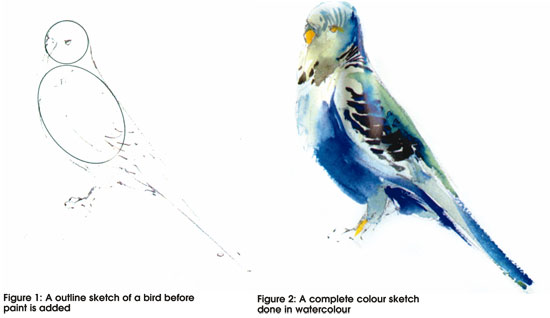|
Learn to draw by Tissa Hewavitarane
Painting birds
The simplest animals to draw and paint are birds. This is due to
their rounded and tapering shape and complicated structure. To paint
birds it is not necessary to go far. You can find a good model at home
or in any pet shop, photographs in books, magazines or in the zoo.
The first thing that a beginner must study is the anatomy of the bird
or animal. Proportions, measurements, shadows and highlights must be
studied before painting.

Painting birds will be one of the subjects that most enthusiasts are
attracted to. In the first place, great attention must be paid to the
initial sketch of the details of the bird. Once the initial sketch is
done by pencil either HB or 2B soft pencil, finish the lines which
define the anatomy of the bird.
Colour
When the drawing is completely finished, you can start to add colour.
The techniques that have been used in drawing birds are the same as
those used for landscapes and still life.
There are various birds. The most popular birds in Sri Lanka are the
parrot, magpie, kingfisher, mynah and the crow to name a few.
When drawing a bird, take a good look at the overall shape of the
bird. Next do the outline drawing before adding the beak, eye and wing
details.
Watch how a bird behaves. See how a bird can stretch or contract the
neck and the way it uses its legs. When colouring the bird the brush
strokes must guide the colour exactly so that the different areas cannot
be confused.
When the first coating of paint is applied, the wet parts of the
paper must not be touched because the colours will get mixed up. At the
finishing stage, pay attention to the colour and light areas.
Figure 1 shows a simple outline sketch done before painting and
figure 2 is a complete sketch in watercolour. Observe the tail of the
bird done with one brush stroke. Thereafter the colours are added. The
head of the bird is done with a very transparent layer on top. The
drawing paper to be used is Kent 250 grams or Whatman drawing paper.
This paper is thick and absorbs colour very quickly.
Brushes Nos 1, 2 and 6 sable hair could be used. Brush No 1 is
usually used for finishing touches and for intricate lines. The colours
could be used according to their body colour. By constant practice you
will become a perfect artist in colouring birds. |

